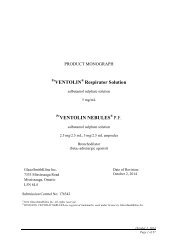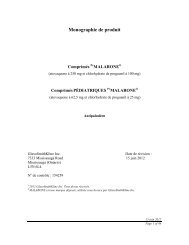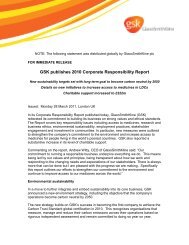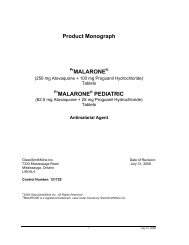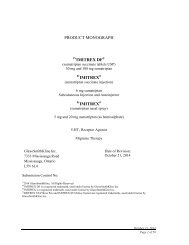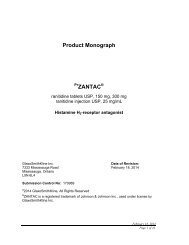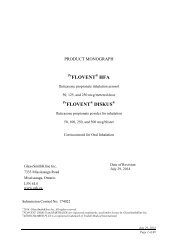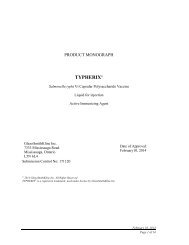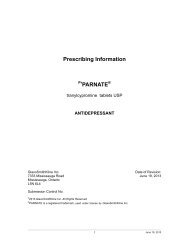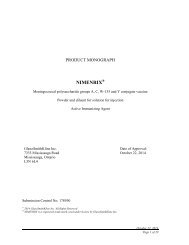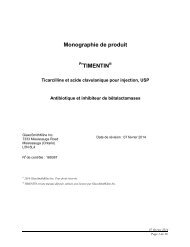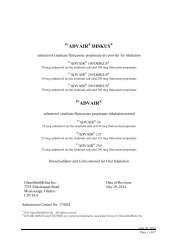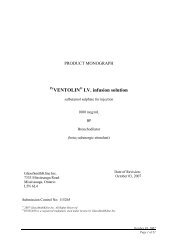Ventolin Diskus - GlaxoSmithKline
Ventolin Diskus - GlaxoSmithKline
Ventolin Diskus - GlaxoSmithKline
You also want an ePaper? Increase the reach of your titles
YUMPU automatically turns print PDFs into web optimized ePapers that Google loves.
Table of ContentsPART I: HEALTH PROFESSIONAL INFORMATION.........................................................3SUMMARY PRODUCT INFORMATION ........................................................................3INDICATIONS AND CLINICAL USE..............................................................................3CONTRAINDICATIONS ...................................................................................................3WARNINGS AND PRECAUTIONS..................................................................................4ADVERSE REACTIONS....................................................................................................6DRUG INTERACTIONS ....................................................................................................9DOSAGE AND ADMINISTRATION..............................................................................10OVERDOSAGE ................................................................................................................11ACTION AND CLINICAL PHARMACOLOGY ............................................................11STORAGE AND STABILITY..........................................................................................12DOSAGE FORMS, COMPOSITION AND PACKAGING .............................................12PART II: SCIENTIFIC INFORMATION ...............................................................................13PHARMACEUTICAL INFORMATION..........................................................................13CLINICAL TRIALS..........................................................................................................14DETAILED PHARMACOLOGY.....................................................................................16TOXICOLOGY .................................................................................................................17REFERENCES ..................................................................................................................19PART III: CONSUMER INFORMATION..............................................................................20October 03, 2007Page 2 of 23
Pr VENTOLIN ® DISKUS ®salbutamol sulphate dry powder for inhalation200 mcg salbutamol/blisterPART I: HEALTH PROFESSIONAL INFORMATIONSUMMARY PRODUCT INFORMATIONRoute ofAdministrationDosage Form /StrengthClinically Relevant NonmedicinalIngredientsOral Inhalation Powder forinhalation/200 mcg /salbutamolLactose (which contains milk protein).For a complete listing see Dosage Forms, Composition and Packaging section.INDICATIONS AND CLINICAL USEVENTOLIN ® (salbutamol sulphate) DISKUS ® inhalation powder is indicated for:• the symptomatic relief and prevention of bronchospasm due to bronchial asthma,chronic bronchitis and other chronic bronchopulmonary disorders in whichbronchospasm is a complicating factor.• the prevention of exercise-induced bronchospasm.Pediatrics (< 4 years of age):The safety and efficacy in children below the age of 4 years has not been established.CONTRAINDICATIONS• Patients with a known or suspected hypersensitivity to any of the ingredients.“For a complete listing, see the DOSAGE FORMS, COMPOSITION, ANDPACKAGING section of the product monograph.• Patients with IgE mediated allergic reactions to lactose (which contains milkprotein) or milk.October 03, 2007Page 3 of 23
WARNINGS AND PRECAUTIONSGeneralPatients should always carry their VENTOLIN ® DISKUS ® inhalation powder to useimmediately if an episode of asthma is experienced. If therapy does not produce asignificant improvement or if the patient’s condition worsens, medical advice must besought to determine a new plan of treatment. In the case of acute or rapidly worseningdyspnea, a doctor should be consulted immediately.Use of Anti-Inflammatory AgentsIn accordance with the present practice for asthma treatment, concomitant antiinflammatorytherapy (eg. corticosteroids) should be part of the regimen if VENTOLIN ®(salbutamol sulphate) DISKUS ® inhalation powder needs to be used more than threetimes a week (not including its use to prevent exercise-induced bronchospasm). It isessential that the physician instruct the patient in the need for further evaluation if thepatient's asthma becomes worse. (See DOSAGE AND ADMINISTRATION).CardiovascularIn individual patients, any beta 2 -adrenergic agonist, including salbutamol sulphate, mayhave a clinically significant cardiac effect. Care should be taken with patients sufferingfrom cardiovascular disorders, especially coronary insufficiency, cardiac arrhythmias andhypertension. Special care and supervision are required in patients with idiopathichypertrophic subvalvular aortic stenosis, in whom an increase in the pressure gradientbetween the left ventricle and the aorta may occur, causing increased strain on the leftventricle.Fatalities have been reported in association with excessive use of inhaledsympathomimetic drugs in patients with asthma. The exact cause of death is unknown,but cardiac arrest following an unexpected development of a severe acute asthmatic crisisand subsequent hypoxia is suspected.Endocrine And MetabolismMetabolic EffectsIn common with other beta-adrenergic agents, salbutamol sulphate can induce reversiblemetabolic changes such as potentially serious hypokalemia, particularly followingnebulised or especially infused administration. Particular caution is advised in acutesevere asthma since hypokalemia may be potentiated by concomitant treatment withxanthine derivatives, steroids and diuretics and by hypoxia. Hypokalemia will increasethe susceptibility of digitalis-treated patients to cardiac arrhythmias. It is recommendedthat serum potassium levels be monitored in such situations.Care should be taken with patients with diabetes mellitus. Salbutamol can inducereversible hyperglycemia during nebulised administration or especially during infusionsof the drug. The diabetic patient may be unable to compensate for this and thedevelopment of ketoacidosis has been reported. Concurrent administration ofcorticosteroids can exaggerate this effect.October 03, 2007Page 4 of 23
Care should be taken with patients with hyperthyroidism.HypersensitivityImmediate hypersensitivity reactions may occur after administration of salbutamolsulphate, as demonstrated by rare cases of urticaria, angioedema, rash, bronchospasm,hypotension, anaphylaxis, and oropharyngeal edema.Care should be taken with patients who are unusually responsive to sympathomimeticamines.NeurologicCare should be taken with patients with convulsive disorders.RespiratoryVENTOLIN ® DISKUS ® inhalation powder can produce paradoxical bronchospasm,which may be life threatening. If paradoxical bronchospasm occurs, VENTOLIN ®DISKUS ® inhalation powder should be discontinued immediately and alternative therapyinstituted.Special PopulationsPregnant Women: Salbutamol has been in widespread use for many years in humanswithout apparent ill consequence. However, there are no adequate and well-controlledstudies in pregnant women and there is little published evidence of its safety in the earlystages of human pregnancy. Administration of any drug to pregnant women should onlybe considered if the anticipated benefits to the expectant woman are greater than anypossible risks to the foetus (See TOXICOLOGY; Teratogenicity Studies).During worldwide marketing experience, rare cases of various congenital anomalies,including cleft palate and limb defects have been reported in the offspring of patientsbeing treated with salbutamol. Some of the mothers were taking multiple medicationsduring their pregnancies. Because no consistent pattern of defects can be discerned, andbaseline rate for congenital anomalies is 2-3%, a relationship with salbutamol use cannotbe established.Labour and delivery: Because of the potential for beta-agonist interference with uterinecontractility, use of VENTOLIN ® DISKUS ® inhalation powder for relief ofbronchospasm during labour should be restricted to those patients in whom the benefitsclearly outweigh the risk.Lactating Women: It is not known whether salbutamol sulphate is excreted in breastmilk after inhalation at recommended doses. Because of the potential fortumorigenicity shown in some animal studies, a decision should be made whether todiscontinue nursing or to discontinue the drug, taking into account the benefit of thedrug to the mother. It is not known whether salbutamol sulphate in breast milk has aharmful effect on the neonate.October 03, 2007Page 5 of 23
Pediatrics: The application of this inhalation system in children depends on the ability ofthe individual child to learn the proper use of the device. During inhalation, childrenshould be assisted or supervised by an adult who knows the proper use of the device.Rarely, in children, hyperactivity occurs and occasionally, sleep disturbances,hallucination or atypical psychosis have been reported.Safety and efficacy in children below 4 years of age have not been established.Geriatrics: As with other beta 2 -agonists, special caution should be observed when usingVENTOLIN ® DISKUS ® in elderly patients who have concomitant cardiovascular diseasethat could be adversely affected by this class of drug.Monitoring And Laboratory TestsIn accordance with the present practice for asthma treatment, patient response should bemonitored clinically and by lung function tests.Monitoring Control of AsthmaFailure to respond for at least three hours to a previously effective dose of VENTOLIN ®DISKUS ® inhalation powder indicates a deterioration of the condition and the physicianshould be contacted promptly. Patients should be warned not to exceed the recommendeddose.The increasing use of fast acting, short duration inhaled beta 2 -adrenergic agonists tocontrol symptoms indicates deterioration of asthma control and the patient's therapy planshould be reassessed. In worsening asthma it is inadequate to increase beta 2 -agonist useonly, especially over an extended period of time. In the case of acute or rapidlyworsening dyspnea, a doctor should be consulted immediately. Sudden or progressivedeterioration in asthma control is potentially life threatening; the treatment plan must bere-evaluated, and consideration be given to corticosteroid therapy (see DOSAGE ANDADMINISTRATION).ADVERSE REACTIONSAdverse Drug Reaction OverviewAs with other bronchodilator inhalation therapy, the potential for paradoxicalbronchospasm should be kept in mind. If it occurs, the preparation should bediscontinued immediately and alternative therapy instituted.Potentially serious hypokalemia may result from β 2 -agonist therapy primarily fromparenteral and nebulised routes of administration (see WARNINGS ANDPRECAUTIONS, Endocrine and Metabolism).October 03, 2007Page 6 of 23
Table 1:Adverse Experiences With ≥3% Incidence in Two 4-Week Chronic DosingStudies With Patients 4 Years of Age and OlderAdverse ExperiencePlacebo* VENTOLIN ® DISKUS ® *Inhalation Powder200mcg four times dailyVENTOLIN ®Inhalation Aerosol*200mcg four timesdailyNumber of patients 136 139 135Central nervous systemHeadache 10% 13% 9%GastrointestinalNausea and vomiting 2% 4% 1%GeneralFever 1% 3% 1%Muscle pain
DRUG INTERACTIONSDrug-Drug InteractionsTable 2-Established or Potential Drug-Drug InteractionsProper name Ref Effect Clinical commentMonoamineoxidase inhibitors ortricyclicantidepressants.Other inhaledsympathomimeticbronchodilators orepinephrine.Beta-blockersDiureticsDigoxinCSCSCSCSCSMay potentiate action ofsalbutamol on cardiovascularsystem.May lead to deleteriouscardiovascular effects.May effectively antagonise theaction of salbutamol.May lead to ECG changesand/or hypokalemia, althoughthe clinical significance ofthese effects is not known.May lead to decrease in serumdigoxin levels. The clinicalsignificance of these findingsfor patients with obstructiveairways disease who arereceiving salbutamol sulphateand digoxin on a chronic basisis unclear.Legend: C = Case Study; CT = Clinical Trial; T = TheoreticalSalbutamol should be administered withextreme caution to patients being treatedwith monoamine oxidase inhibitors ortricyclic antidepressants.Other inhaled sympathomimeticbronchodilators or epinephrine shouldnot be used concomitantly withsalbutamol sulphate. If additionaladrenergic drugs are to be administeredby any route to the patient using inhaledsalbutamol sulphate, the adrenergicdrugs should be used with caution.Such concomitant use must beindividualized and not given on a routinebasis. If regular coadministration isrequired then alternative therapy must beconsidered.Beta-adrenergic blocking drugs,especially the non-cardioselective ones,such as propranolol, should not usuallybe prescribed together.The ECG changes and/or hypokalemiathat may result from the administrationof non-potassium sparing diuretics (suchas loop or thiazide diuretics) can beacutely worsened by beta-agonists,especially when the recommended doseof the beta-agonist is exceeded. Cautionis advised in the coadministration ofbeta-agonists with non-potassiumsparing diuretics.Mean decreases of 16-22% in serumdigoxin levels were demonstrated aftersingle dose intravenous and oraladministration of salbutamol,respectively, to normal volunteers whohad received digoxin for 10 days. Itwould be prudent to carefully evaluateserum digoxin levels in patients who arecurrently receiving digoxin andsalbutamol sulphate.October 03, 2007Page 9 of 23
DOSAGE AND ADMINISTRATIONDosing ConsiderationsThe dosage should be individualised, and the patient's response should be monitored bythe prescribing physician on an ongoing basis.In accordance with the current Canadian asthma guidelines, if salbutamol sulphateis required for relief of symptoms more than three times a week, (not including itsuse to prevent exercise induced bronchospasm), anti-inflammatory therapy (e.g.corticosteroids) should be part of the regimen.Increasing demand for VENTOLIN ® (salbutamol sulphate) DISKUS ® inhalation powderin bronchial asthma is usually a sign of worsening asthma and indicates that the treatmentplan should be reviewed.If a previously effective dose fails to provide the usual relief, or the effects of a doselast for less than three hours, patients should seek prompt medical advice since thisis usually a sign of worsening asthma.As there may be adverse effects associated with excessive dosing, the dosage orfrequency of administration should only be increased on medical advice. However, if amore severe attack has not been relieved by the usual dose, additional doses may berequired. In these cases, patients should immediately consult their doctors or the nearesthospital.Recommended Dose And Dosage AdjustmentAdults andChildren (4 yearsand older)AcuteSymptoms*One Inhalation(200 mcg) asrequiredIntermittentand Long termTreatment **One Inhalation(200 mcg) three tofour times dailyPrevention ofExercise –induced AsthmaOne Inhalation(200 mcg) 15minutes beforeexercise.Maximum DailyDose(Total dailydose should notexceed)Four Inhalations(800 mcg)* If a more severe attack has not been relieved by the usual dose, further inhalations may be required. Inthese cases, patients should immediately consult their doctors or the nearest hospital.** If despite appropriate anti-inflammatory therapy (e.g. corticosteroids), regular daily use of theVENTOLIN ® DISKUS ® inhalation powder remains necessary for the control of bronchospasm.Missed DoseIf a single dose is missed, instruct the patient to take the next dose when it is due or ifthey become wheezy.October 03, 2007Page 10 of 23
AdministrationVENTOLIN ® DISKUS ® inhalation powder is administered by the inhaled route only.To ensure administration of the proper dose of the drug, the patient should be instructedby the physician or other health professional in the proper use of the DISKUS ® inhalationdevice.OVERDOSAGESymptoms and SignsThe most common signs and symptoms of overdose with salbutamol are transientbeta agonist pharmacologically mediated events (see Warnings and Precautions andAdverse Reactions). Overdosage may cause tachycardia, cardiac arrhythmia,hypokalemia, hypertension and, in extreme cases, sudden death. Serum potassium levelsshould be monitored.TreatmentConsideration should be given to discontinuation of treatment and appropriatesymptomatic therapy. To antagonise the effect of salbutamol, the judicious use of acardioselective beta-adrenergic blocking agent (e.g. metoprolol, atenolol) may beconsidered, bearing in mind the danger of inducing an asthmatic attack. There isinsufficient eveidence to determine if dialysis is beneficial for overdosage ofVENTOLIN ® (salbutamol sulphate) DISKUS ® inhalation powder.ACTION AND CLINICAL PHARMACOLOGYMechanism Of ActionSalbutamol produces bronchodilation through stimulation of beta 2 -adrenergic receptors inbronchial smooth muscle, thereby causing relaxation of bronchial muscle fibres. Thisaction is manifested by an improvement in pulmonary function as demonstrated byspirometric measurements. At therapeutic doses, salbutamol has little action on the beta 1 -adrenergic receptors in cardiac muscle.In pediatric, adolescent and adult patients, the median onset of effect ranged from 3.0 to3.6 minutes, and the median duration of effect ranged from 2.9 to 4.9 hours. In somepatients, duration of effect was as long as 6 hours (see PHARMACOLOGY; Human).October 03, 2007Page 11 of 23
PharmacokineticsAfter inhalation of recommended doses of salbutamol, plasma drug levels are very low.When 100mcg of titrated salbutamol aerosol was administered to two normal volunteers,plasma levels of drug-radioactivity were insignificant at 10, 20 and 30 minutes followinginhalation. The plasma concentration of salbutamol may be even less as the amount ofplasma drug-radioactivity does not differentiate salbutamol from its principal metabolite,a sulphate ester. In a separate study, plasma salbutamol levels ranged from less than0.5 ng/mL to 1.6 ng/mL in ten asthmatic children one hour after inhalation of 200 mcg ofsalbutamol.Approximately 10% of an inhaled salbutamol dose is deposited in the lungs. Eighty-fiveper cent of the remaining salbutamol administered from a metered-dose inhaler isswallowed, however, since the dose is low (100 to 200 mcg), the absolute amountswallowed is too small to be of clinical significance. Salbutamol is only weakly bound toplasma proteins. Results of animal studies indicate that following systemicadministration, salbutamol does not cross the blood-brain barrier but does cross theplacenta using an in vitro perfused isolated human placenta model. It has been found thatbetween 2% and 3% of salbutamol was transferred from the maternal side to the fetal sideof the placenta.Salbutamol is metabolized in the liver. The principal metabolite in humans is salbutamolo-sulphate,which has negligible pharmacologic activity. Salbutamol may also bemetabolized by oxidative deamination and/or conjugation with glucuronide.Salbutamol is longer acting than isoprenaline in most patients by any route ofadministration because it is not a substrate for the cellular uptake processes forcatecholamines nor for catechol-O-methyl transferase. Salbutamol and its metabolites areexcreted in the urine (>80%) and the feces (5% to 10%). Plasma levels are insignificantafter administration of aerosolized salbutamol; the plasma half-life ranges from 3.8 to 7.1hours.STORAGE AND STABILITYKeep out of the reach of children. Do not store above 30°C. Keep in a dry place.DOSAGE FORMS, COMPOSITION AND PACKAGINGVENTOLIN ® DISKUS ® inhalation powder is a disposable blue-coloured plastic inhalerdevice containing a foil strip with 60 blisters. Each blister contains 200 mcg ofsalbutamol (as sulphate) as active ingredient. It also contains lactose (milk sugar),including milk protein, which acts as the ‘carrier’.VENTOLIN ® DISKUS ® inhalation powder is a dry powder inhalation device thatdelivers 200 mcg of salbutamol (as sulphate) per inhalation.October 03, 2007Page 12 of 23
PART II: SCIENTIFIC INFORMATIONPHARMACEUTICAL INFORMATIONDrug SubstanceProper name:Chemical name:salbutamol sulphateα 1 -[tert-butylamino)methyl]-4-hydroxy-m-xyleneα,α’-diol sulphate (2:1) saltMolecular formula and molecular mass: (C 13 H 21 NO 3 ) 2 • H 2 SO 4, 576.7Structural formula:Physicochemical properties:Physical Form:Solubility:White to almost white powder.Soluble in water and slightly soluble in ethanol.October 03, 2007Page 13 of 23
Percent Change From Same Day Baseline in FEV 1 From Two 4-Week ClinicalTrials in Patients ≥6 Years of Age: Treatment Week 4In both adolescent/adult and pediatric studies, the majority of patients achieved ≥15%increase in FEV 1 (or PEFR) within 15 minutes after inhalation of VENTOLIN ®DISKUS ® inhalation powder 200 mcg. Additional analyses were performed on allpatients who responded within 30 minutes. For these patients, the median onset of effectranged from 3 to 3.6 minutes, and the median duration of effect ranged from 2.9 to 4.9hours. In some patients, duration of effect was as long as 6 hours. Greater than 90% ofboth adolescent/adult and pediatric patients complied with the dosing instructions ofVENTOLIN ® DISKUS ® inhalation powder.Similarly, the majority of patients in both the adolescent/adult and pediatric studiesachieved ≥15% increase in FEV 1 (or PEFR) within 15 minutes after inhalation ofVENTOLIN ® Inhalation Aerosol 200 mcg. Additional analyses were performed on allpatients who responded within 30 minutes. For these patients, the median onset of effectranged from 3 to 4.2 minutes, and the median duration of effect ranged from 1.7 to 5.8hours. In some patients, duration of effect was as long as 6 hours.A single dose crossover trial compared 200 and 400 mcg VENTOLIN ® DISKUS ®inhalation powder with 100, 200, and 400 mcg VENTOLIN ® Inhalation Aerosol andplacebo in patients 4 to 11 years of age with asthma. All treatments were significantlybetter than placebo in improving pulmonary function. Results of serial PEFR testingdemonstrated that the peak effect within 30 minutes of dosing, expressed as percentchange from test-day baseline, was 23.6% for VENTOLIN ® DISKUS ® inhalation powder200 mcg, compared with 19.9% for VENTOLIN ® Inhalation Aerosol 200 mcg. In thissingle dose study, the majority of patients achieved ≥15% increase in PEFR within 30minutes after inhalation of VENTOLIN ® DISKUS ® inhalation powder 200 mcg. Forthese patients, the median onset of effect was 3.6 minutes, and the median duration ofeffect was 5 hours. In some patients, duration of effect was as long as 6 hours.October 03, 2007Page 15 of 23
A single dose crossover trial compared VENTOLIN ® DISKUS ® inhalation powder200 mcg with VENTOLIN ® Inhalation Aerosol 200 mcg and placebo in patients 18 yearsof age and older with exercise-induced bronchospasm (EIB). Both treatments werecomparable and significantly better than placebo in maintaining pulmonary function andprotecting against EIB.DETAILED PHARMACOLOGYAnimalIn vitro studies and in vivo pharmacologic studies have demonstrated that salbutamol hasa preferential effect on beta 2 -adrenergic receptors compared with isoprenaline. While it isrecognized that beta 2 -adrenergic receptors are the predominant receptors in bronchialsmooth muscle, recent data indicate that there is a population of beta 2 -receptors in thehuman heart existing in a concentration between 10% and 50%. The precise function ofthese, however, is not yet established.The pharmacologic effects of beta-adrenergic agonist drugs, including salbutamol, are atleast in part attributable to stimulation through beta-adrenergic receptors of intracellularadenyl cyclase, the enzyme that catalyzes the conversion of adenosine triphosphate(ATP) to cyclic-3',5'-adenosine monophosphate (cAMP). Increased cAMP levels areassociated with relaxation of bronchial smooth muscle and inhibition of release ofmediators of immediate hypersensitivity from cells, especially from mast cells.The muscle-relaxing effect of salbutamol was found to be more prolonged than when theeffect was induced by isoprenaline. As suggested from the results of experiments inisolated animal tissues, salbutamol has been shown to produce a substantialbronchodilator effect in the intact animal. In the anaesthetised guinea pig, salbutamolcompletely prevents acetylcholine-induced bronchospasm at the dose of 100 mcg/kgintravenously.Administration of salbutamol aerosol at a dose of 250 mcg/mL for one minute to guineapigs prevented acetylcholine-induced bronchospasm without any chronotropic effect. Aprolonged bronchodilator effect of salbutamol compared to isoprenaline (in terms ofmean times to dyspnea following acetylcholine challenge) was observed following oraladministration of salbutamol to conscious guinea pigs. The protective action ofsalbutamol in this case persisted for up to six hours.In anaesthetised cats and dogs, salbutamol prevented the bronchospasm elicited by vagalstimulation without any significant effect on heart rate and blood pressure. Comparativetests of salbutamol and isoprenaline in isolated dog papillary muscle, guinea pig atrialmuscle and human heart muscle have shown that the effect of salbutamol on beta 1 -adrenergic receptors in the heart is minimal.In a number of studies using guinea pig atria, it was found that on a weight-to-weightbasis, salbutamol was from 2,000 to 2,500 times less active in terms of inotropic effectOctober 03, 2007Page 16 of 23
and 500 times less active in terms of chronotropic effect than isoprenaline. Compared toorciprenaline, salbutamol was about 40 times less active in terms of inotropic effect andfour times less potent in terms of chronotropic effect. Salbutamol has been shown to beone-fifth as potent a vasodilator in skeletal muscle as isoprenaline, as measured by effectson hind limb blood flow in the anaesthetised dog. In the perfused rabbit ear, salbutamolwas shown to possess only one-tenth the activity of isoprenaline in terms of vasodilatingeffect. In dogs, salbutamol was shown to increase coronary blood flow, which wassubsequently shown to be the result of a direct coronary vasodilating effect of salbutamol.In six dogs with right-sided cardiac by-pass, salbutamol, given at the dose of 25 mcg/kg,improved left ventricular efficiency and increased coronary blood flow. Recent studies inminipigs, rodents, and dogs recorded the occurrence of cardiac arrhythmias and suddendeath (with histologic evidence of myocardial necrosis) when beta-agonists andmethylxanthines were administered concurrently. The significance of these findings whenapplied to humans is currently unknown.Animal studies show that salbutamol does not pass the blood brain barrier.TOXICOLOGYAcute ToxicitySpecies (n) Oral LD 50 Intravenous LD 50Mouse (10) > 2000 mg/kg 72 mg/kgRat (10) > 2000 mg/kg 60 mg/kgRat (n) Intraperitoneal LD 50Newborn (155)216 mg/kgWeanling (100)524 mg/kg2 week old (90) 437 mg/kgThe rate of respiration in test animals initially increased, but subsequently becameabnormally slow and deep. Death, preceded by convulsions and cyanosis, usuallyoccurred within four hours after drug administration.Rabbits, cats and dogs survived a single dose of 50mg/kg salbutamol.Intermediate (Four Months) ToxicityRats received salbutamol twice daily, in oral doses from 0.5 to 25 mg/kg, on anincreasing scale. The only significant hematological changes were a small increase inhemoglobin and packed cell volume. BUN and SGOT values were elevated while bloodglucose and plasma protein levels remained unchanged. Pituitaries had increased amountof PAS-positive material in the cleft at the higher dose levels.October 03, 2007Page 17 of 23
Salbutamol was given to dogs twice daily, in oral doses from 0.05 to 12.5 mg/kg, on anincreasing scale. The rate of increase of hemoglobin and packed cell volume wasdepressed, particularly at higher doses. Leukocyte count decreased after sixteen weeks oftreatment at each dose level. Platelet count was increased after eight weeks at the highestdose. No significant biochemical effects were observed. The only significant histologicalchange was the appearance of corpora amylacea in the stomach which was attributed toaltered mucus secretion. Inhalation of 1000 mcg of salbutamol aerosol twice daily forthree months did not produce any morphological changes in the lungs, trachea, lymphnodes, liver or heart.Long-Term ToxicityFifty female, Charles River CD Albino rats received salbutamol orally at 2, 10 and50 mg/kg/day for one hundred and four weeks; fifty female Charles River CD Sprague-Dawley-derived rats received 20 mg/kg/day salbutamol orally for fifty weeks, and fiftyfemale Charles River Long-Evans rats received 20 mg/kg/day salbutamol orally forninety-six weeks. These rat studies demonstrated a dose-related incidence of mesovarianleiomyomas. No similar tumors were seen in mice.MutagenicityIn vitro tests involving four micro-organisms revealed no mutagenic activity.CarcinogenicityIn a two-year study in the rat, salbutamol sulphate caused a significant dose-relatedincrease in the incidence of benign leiomyomas of the mesovarium at dosescorresponding to 111, 555, and 2,800 times the maximum human inhalation dose. Inanother study, the effect was blocked by the co-administration of propranolol. Therelevance of these findings to humans is not known. An 18-month study in mice and alifetime study in hamsters revealed no evidence of tumorigenicity.Teratogenicity StudiesSalbutamol has been shown to be teratogenic in mice when given in doses correspondingto 14 times the human aerosol dose; when given subcutaneously in doses correspondingto 0.2 times the maximum human (child weighing 21 kg) oral dose; and when givensubcutaneously in doses corresponding to 0.4 times the maximum human oral dose.A reproduction study in CD-1 mice given salbutamol at doses of 0.025, 0.25, and2.5 mg/kg subcutaneously, corresponding to 1.4, 14, and 140 times the maximum humanaerosol dose respectively, showed cleft palate formation in 5 of 111 (4.5%) fetuses at0.25 mg/kg and in 10 of 108 (9.3%) fetuses at 2.5mg/kg. No cleft palates were observedat a dose of 0.025 mg/kg salbutamol. Cleft palate occurred in 22 of 72 (30.5%) fetusestreated with 2.5 mg/kg isoprenaline (positive control).In rats, salbutamol treatment given orally at 0.5. 2.32, 10.75 and 50 mg/kg/daythroughout pregnancy resulted in no significant fetal abnormalities. However, at thehighest dose level there was an increase in neonatal mortality. Reproduction studies inrats revealed no evidence of impaired fertility.October 03, 2007Page 18 of 23
Salbutamol had no adverse effect when given orally to Stride Dutch rabbits, at doses of0.5, 2.32 and 10.75 mg/kg/day throughout pregnancy. At a dose of 50 mg/kg/day, whichrepresents 2800 times the maximum human inhalation dose, cranioschisis was observedin 7 of 19 (37%) fetuses.A reproduction study in New Zealand White rabbits using salbutamol sulfate/HFA-134aformulation, revealed enlargement of the frontal portion of the fontanelles in 6 of 95 (6%)and 15 of 107 (14%) fetuses at 28 and 149 mcg/kg, respectively (approximately 2/5 and 2times, respectively, the maximum recommended human daily dose on a mg/m 2 basis),giving plasma levels of approximately 12 and 60 ng/mL, respectively.REFERENCES1. VENTOLIN ® Inhalation Products currently approved Product Monograph.2. Anonymous. Salbutamol: A review. Drugs 1971;4:274-302.3. The Canadian Asthma Consensus Conference. Can Resp J 1996; 3(2):89-100.4. Libretto S. A review of the toxicology of salbutamol (albuterol). Arch Toxicol1994; 68: 213-216.October 03, 2007Page 19 of 23
IMPORTANT: PLEASE READPART III: CONSUMER INFORMATIONPr VENTOLIN ® DISKUS ®salbutamol sulphateThis leaflet is part III of a three-part "Product Monograph" forVENTOLIN ® DISKUS ® and is designed specifically forConsumers. This leaflet is a summary and will not tell youeverything about VENTOLIN ® DISKUS ® . Please read thisleaflet carefully before you start to take your medicine or startadministering it to a child. Contact your doctor or pharmacistif you have any questions about the drug. This medicine is foryou. Only a doctor can prescribe if for you. Never give it tosomeone else. It may harm them even if their symptoms arethe same as yours.ABOUT THIS MEDICATIONWhat the medication is used for:Your doctor has prescribed a medicine called VENTOLIN ®(salbutamol sulphate) DISKUS ® inhalation powder to you. Itis used to help breathing problems in:• Asthma• Other chest illnesses.What it does:Salbutamol is one of a group of medicines calledbronchodilators. Salbutamol relaxes the muscles in the wallsof the small air passages in the lungs. This helps to open upthe airways and so helps to relieve chest tightness, wheezingand cough so that you can breathe more easily.When it should not be used:Do not use if you are allergic to it or any of the components ofits formulation including lactose (milk sugar) or milk protein(see What the important nonmedicinal ingredients are).What the medicinal ingredient is:VENTOLIN ® DISKUS ® inhalation powder contains the activeingredient, salbutamol sulphate.What the important nonmedicinal ingredients are:VENTOLIN ® DISKUS ® inhalation powder contains lactose(milk sugar), including milk protein which acts as the‘carrier’.What dosage forms it comes in:VENTOLIN ® DISKUS ® inhalation powder is a disposableblue-coloured plastic inhaler device containing a foil stripwith 60 blisters. Each blister contains 200 mcg of the activeingredient salbutamol (as the sulphate salt). The blistersprotect the powder for inhalation from effects of theatmosphere.WARNINGS AND PRECAUTIONSBefore you use VENTOLIN ® DISKUS ® talk to your doctor orpharmacist if:• You have ever had to stop taking other medicines forthis illness because you were allergic to them or theycaused problems.• You are having treatment for a thyroid condition.• You are having treatment for high blood pressure or aheart problem.• You have been told that you are allergic to lactose(milk sugar) or milk protein.• If you have diabetes.• If you have a past history of seizures.If the relief of wheezing or chest tightness is not as good asusual, tell your doctor as soon as possible. If you notice asudden worsening of your shortness of breath and wheezeshortly after taking your medicine, tell your doctor as soon aspossible. It may be that your chest condition is worsening andyou may need to add another type of medicine to yourtreatment.Your doctor may decide not to prescribe this medicine duringthe first 3 months of pregnancy, nor if you are breast feeding ababy. However, there may be circumstances when your doctoradvises you differently.INTERACTIONS WITH THIS MEDICATIONMake sure that your doctor knows what other medicines youare taking (such as those for depression, allergies, other airwayopeningmedications (e.g. other asthma medications) bloodpressure and heart medications, and water pills (diuretics),etc.), including those you can buy without a prescription aswell as herbal and alternative medicines.PROPER USE OF THIS MEDICATIONCarefully follow the instructions shown. If you have anyproblems, tell your doctor of pharmacist.It is important that your use your VENTOLIN ® DISKUS ®inhalation powder properly to ensure that you receivemaximum benefit from your medicine.When you take your DISKUS ® inhalation device out of its box,it will be in the closed position.A new DISKUS ® inhalation device contains 60 individuallyprotected doses of your medicine, in powder form. The devicehas a dose counter which tells you the number of dosesremaining. It counts down from 60 to 1. To show when theOctober 03, 2007Page 20 of 23
IMPORTANT: PLEASE READlast five doses have been reached the numbers appear inred.Each dose is accurately measured and hygienically protected.It requires no maintenance, and no refilling.The DISKUS ® inhalation device is easy to use. When youneed a dose, just follow the four simple steps illustrated:1. Open2. Slide3. Inhale4. CloseSliding the lever of your DISKUS ® inhalation device opens asmall hole in the mouthpiece and unwraps a dose ready foryou to inhale it. When you close the DISKUS ® inhalationdevice, the lever automatically moves back to its originalposition ready for your next dose when you need it. The outercase protects your DISKUS ® inhalation device when it is notin use.1. OpenTo open your DISKUS ® inhalation devicehold the outer case in one hand and put thethumb of your other hand on the thumbgrip. Push your thumb away from you asfar as it will go.2. SlideHold your DISKUS ® inhalation devicewith the mouthpiece towards you. Slide thelever away from you as far as it will go –until it clicks. Your DISKUS ® inhalationdevice is now ready to use. Every time thelever is pushed back a dose is madeavailable for inhaling. This is shown by thedose counter. Do not play with the lever asthis releases dose which will be wasted.3. InhaleBefore you start to inhale the dose readthough this section carefully.• Hold the DISKUS ® inhalation deviceaway from your mouth. Breathe out asfar as is comfortable. Remember –never breathe into your DISKUS ®inhalation device.• Put the mouthpiece to your lips.Breathe in steadily and deeply –through the DISKUS ® inhalationdevice, not through your nose.• Remove the DISKUS ® inhalationdevice from your mouth.• Hold your breath for about 10 secondsor for as long as is comfortable.• Breathe out slowly.4. CloseTo close your DISKUS ® inhalation device,put your thumb in the thumb grip, and slidethe thumb grip back towards you, as far asit will go.When you close the DISKUS ® inhalationdevice, it clicks shut. The leverautomatically returns to its originalposition and is reset. Your DISKUS ®inhalation device is now ready for your touse again.RememberKeep your DISKUS ® inhalation device dry.Keep it closed when not in use.Never breathe into your DISKUS ® inhalation device. Onlyslide the lever when you are ready to take a dose.During inhalation, children should be assisted or supervised byan adult who knows the proper use of the device.Usual dose:Use your VENTOLIN ® DISKUS ® inhalation powder only asdirected by your doctor, nurse or pharmacist. Your doctor willtell you how often you should use your DISKUS ® inhalationdevice. If you are not sure how much or when to take yourmedicine, ask your doctor or pharmacist.The action of VENTOLIN ® (salbutamol sulphate) may last upto 6 hours and should last at least 4 hours. Call you doctorimmediately if the effect lasts for less than 3 hours or if younotice a sudden worsening of your shortness of breath. Donot increase the dose or the number of times you use yourmedicine without asking your doctor. If symptoms getworse or you require your DISKUS ® inhalation devicemore than before, tell you doctor as soon as possible.When using VENTOLIN ® DISKUS ® inhalation powder, othermedicines (including asthma medicines) should only be usedwhen prescribed by your doctor.Unless your doctor has recommended otherwise, the total dailydose for adults and children (4years and older) should notexceed 4 inhalations (800 mcg).If you regularly use one inhalation of VENTOLIN ®DISKUS ® inhalation powder more than three times a week,and take no other asthma medication, you should talk toyou doctor who may want to reassess your treatment plan.Do not take more doses or use your DISKUS ® inhalationdevice more often than your doctor advises.October 03, 2007Page 21 of 23
IMPORTANT: PLEASE READIf you have to go to hospital for an operation, take yourDISKUS ® inhalation device with you and tell the doctor whatmedicine(s) you are taking.Overdose:If you accidentally take a larger dose than prescribed, youare more likely to get side effects like a faster heart beat,headaches and feeling shaky or restless. These effects usuallywear off within a few hours, but you should tell your doctor assoon as possible.In the event of an excessive overdosage tell your doctorwithout delay or contact your nearest hospital emergencydepartment or poison control centre. Take this leaflet or yourmedication with you so that the hospital or poison controlcentre will know what you have taken.Missed Dose:If you forget to inhale a dose do not worry, just inhale the nextdose when it is due or if you become wheezy. Your doctormay have told you to use your DISKUS ® inhalation deviceregularly every day, or only when you are wheezy or short ofbreath.SIDE EFFECTS AND WHAT TO DO ABOUT THEMVery occasionally some people feel a little shaky or have aheadache or notice that their heart is beating a little fasterand/or more forcefully than usual after using VENTOLIN ®DISKUS ® inhalation powder. Muscle cramps can occur,although these are quite rare. These effects usually wear offwithin a few hours, but you should tell your doctor as soon aspossible. If you feel unwell in any other way or have anysymptoms that you do not understand or if your heart beatfeels irregular, you should contact your doctor immediately.This is not a complete list of side effects. If you have anyunexpected effects after receiving VENTOLIN ® DISKUS ® ,contact your doctor or pharmacist.• Sudden wheeziness and chest pain or tightness.• Swelling of eyelids, face, lips, tongue or throat.• Lumpy skin rash or “hives” anywhere on the body.HOW TO STORE ITKeep your medicine in a safe place where children cannotreach it. Your medicine may harm them.Do not store VENTOLIN ® DISKUS ® inhalation powder above30 ° C. Keep in a dry place.REPORTING SUSPECTED SIDE EFFECTSTo monitor drug safety, Health Canada collectsinformation on serious and unexpected effects of drugs. Ifyou suspect you have had a serious or unexpected reactionto this drug you may notify Health Canada by:toll-free telephone: 866-234-2345toll-free fax 866-678-6789By email: cadrmp@hc-sc.gc.caBy regular mail:National AR CentreMarketed Health Products Safety and EffectivenessInformation DivisionMarketed Health Products DirectorateTunney’s Pasture, AL 0701COttawa ON K1A 0K9NOTE: Before contacting Health Canada, you shouldcontact your physician or pharmacist.SERIOUS SIDE EFFECTS, HOW OFTEN THEYHAPPEN AND WHAT TO DO ABOUT THEMN THEY HAPPEN AND WHAT TO DO ABOUT THEMIf you notice a sudden worsening of your shortness of breathand wheeze shortly after using your VENTOLIN ® DISKUS ® ,tell your doctor as soon as possible.Some people can be allergic to medicines. If you have any ofthe following symptoms soon after taking VENTOLIN ®DISKUS ® , stop taking this medicine and tell your doctorimmediately.October 03, 2007Page 22 of 23
IMPORTANT: PLEASE READMORE INFORMATIONYou may need to read this leaflet again. PLEASE DO NOTTHROW IT AWAY until you have finished your medicine.This document plus the full product monograph, preparedfor health professionals can be found at:http://www.gsk.caor by contacting the sponsor, <strong>GlaxoSmithKline</strong> Inc.7333Mississauga RoadMississauga, OntarioL5N 6L41-800-387-7374This leaflet was prepared by <strong>GlaxoSmithKline</strong> Inc.Last revised: October 03, 2007© 2007 <strong>GlaxoSmithKline</strong> Inc. All Rights Reserved.® VENTOLIN and DISKUS are registered trademarks, used underlicense by <strong>GlaxoSmithKline</strong> Inc.October 03, 2007Page 23 of 23



